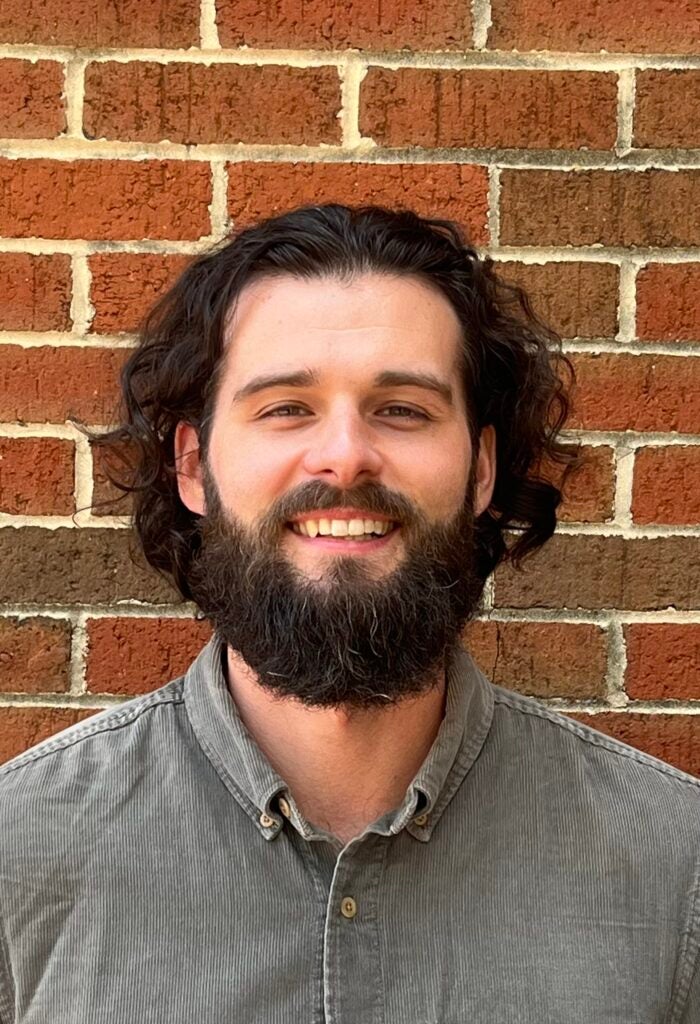2025 – 2026 Soft Matter Graduate Fellowship Recipients
Posted in News Story
The ISM is excited to introduce the 2025-2026 Soft Matter Graduate Fellowship recipients: Rose Tchuenkam Batoum and Andrew Hoy!

Rose Tchuenkam Batoum
Advisor: Professor Emanuela Del Gado
My research explores the structure, cooperative dynamics, and nonlinear mechanics of amorphous materials, with the overarching goal of advancing our understanding of tissue mechanics to inform biomimetic material design. Amorphous soft materials like single and multicomponent gels are prevalent in biological systems and represent a rapidly growing area in materials science. My work centers on fibrillar double-network gels, which draw inspiration from biological assemblies such as actin filaments and microtubules. These structures arise from complex hierarchical aggregation of proteins and form stress-bearing networks capable of withstanding substantial deformation, and in some cases, exhibit self-healing behavior.
Utilizing a three-dimensional computational model of self-assembling particles that undergo gelation through a non-equilibrium, non-ergodic quenching process, I am able to replicate the phenomenology of biopolymeric networks. Within these double-network colloidal gels, I demonstrate that a symmetric binary mixture can give rise to two distinct structural motifs by merely tuning the interspecies interactions:
- Demixed networks, where the two species form spatially segregated domains, resulting in a three-dimensional checkerboard-like pattern.
- Intertwined networks, where branches of the two networks are closely co-localized and, in some cases, wrapped around one another.
These two architectures have been observed in experimental systems such as DNA-coated nanoparticle gels and composite materials comprised of extracellular matrix components like collagen and fibronectin, as well as cytoskeletal networks of actin and microtubules, all of which display either demixed or intertwined morphologies.
By systematically generating a wide array of composite structures, I establish a direct link between network architecture and mechanical response. Specifically:
- Demixed architectures exhibit remarkable robustness against environmental perturbations.
- Intertwined networks demonstrate higher tunability and ultra-toughness.
These findings were detailed in a recent publication: https://doi.org/10.1073/pnas.2423293122
Building upon this understanding of interspecies interactions, I plan to perform computational cyclic shear tests to uncover the microscopic mechanisms responsible for the enhanced toughness observed in our double-network models under shear deformation. Experimental studies on multi-network gels have shown that cyclic deformation induces hysteresis, indicative of fatigue resistance and potential self-healing. A prevailing hypothesis attributes this behavior to the presence of sacrificial bonds in one of the networks, which rupture under stress and thereby offload strain from the secondary network. I am currently conducting spatially resolved statistical analyses within my simulations to evaluate the validity of this hypothesis.
As a second-year Ph.D. student, I am developing computational frameworks, simulation methodologies, and advanced visualization tools to investigate mechanical coupling and ultra-toughening mechanisms in multicomponent gels. My work involves programming in Python and C++, and employing the molecular dynamics engine LAMMPS. In addition to adapting existing codebases from my research group, I am writing new scripts to run large-scale simulations on a Google Cloud high-performance computing cluster.

Andrew Hoy
Advisor: Professor Rodrigo Maillard
My research focuses on the regulatory subunit type Iβ of PKA (PKA RIβ) which is predominantly expressed in neurons and plays a key role in learning and memory. PKA RIβ has been linked to neurodegeneration, specifically through the L50R mutation, which was identified in protein aggregates in the hippocampus, substantia nigra and cerebellum of patients with dementia and parkinsonism. This mutation was hypothesized to drive aggregation of PKA RIβ and was implicated as a causative factor in the associated neurodegeneration. My goal is to elucidate the molecular mechanisms by which the L50R mutation promotes aggregation in PKA RIβ.
The L50R mutation is located within the dimerization and docking (DD) domain of PKA RIβ. This domain mediates homodimerization and docks with A-kinase anchoring proteins (AKAPs), thereby facilitating cellular compartmentalization and the formation of localized PKA signaling islands. To investigate the molecular mechanisms underlying aggregation, I purified and isolated insoluble aggregates, soluble oligomers and monomers of the DD domain from both PKA RIβ wildtype and L50R. Using a combination of biophysical and biochemical techniques, such as fluorescence anisotropy, fluorescence spectroscopy and circular dichroism, I characterized the assembly state, stability, secondary structure and AKAP binding properties of each species.
My results indicate the L50R mutation disrupts the protein’s native helical structure, preventing the formation of two native disulfide bonds present in wildtype. Moreover, I demonstrated that oligomerization in the L50R mutant was abolished by either mutating the cysteine residues to alanine or by chemically reducing the cysteine residues. Therefore, I hypothesize that oligomerization in PKA RIβ L50R is largely driven by nonnative disulfide bond formation. Moving forward, I plan to systematically evaluate the contribution of each cysteine residue to oligomerization by characterizing all possible combinations of Cys-to-Ala mutants. Additionally, in collaboration with the Physical Measurement Laboratory at NIST, I aim to more precisely elucidate the assembly state and mechanism of L50R soluble oligomer formation using biological nanopores–an approach that is emerging as an invaluable technology for characterizing the soluble oligomeric intermediates that precede the formation of insoluble protein aggregates.
